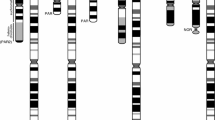Abstract
Except for individuals with variations in the pericentric heterochromatic chromosomal regions (including acrocentric short arms), a distinction of homologue chromosomes on a single-cell level is not possible. Due to this limitation, various questions of scientific and diagnostic relevance could not be studied by now. Based on copy number variations (CNV) spanning up to several megabasepair of DNA, we developed a molecular cytogenetic approach for an interindividual differentiation of homologue chromosomes, the so-called parental origin determination FISH (pod-FISH) technique. For this, all human chromosomes were covered with CNV-spanning BAC-probes in one- up to five-color chromosome-specific pod-FISH sets. With this approach to study the parental origin of individual human chromosomes on a single-cell level, new horizons for diagnostics and basic research were opened.
Access this chapter
Tax calculation will be finalised at checkout
Purchases are for personal use only
Similar content being viewed by others
References
Lee C (2005) Vive la difference! Nat Genet 37:660–661
Schlötterer C (2004) The evolution of molecular markers—just a matter of fashion? Nat Rev Genet 5:63–69
Liehr T, Nietzel A, Starke H et al (2003) Characterization of small marker chromosomes (SMC) by recently developed molecular cytogenetic approaches. J Assoc Genet Technol 29:5–10
Nietzel A, Albrecht B, Starke H et al (2003) Partial hexasomy 15pter–>15q13 including SNRPN and D15S10: first molecular cytogenetically proven case report. J Med Genet 40:e28
Müller H, Klinger HP, Glasser M (1975) Chromosome polymorphism in a human newborn population II: potentials of polymorphic chromosome variants for characterizing the idiogram of an individual. Cytogenet Cell Genet 15:239–255
Liehr T (2014) Benign & pathological chromosomal imbalances, 1st edition microscopic and submicroscopic copy number variations (CNVs) in genetics and counseling. Academic Press, New York
Iafrate AJ, Feuk L, Rivera MN et al (2004) Detection of large-scale variation in the human genome. Nat Genet 36:949–951
Sebat J, Lakshmi B, Troge J et al (2004) Large-scale copy number polymorphism in the human genome. Science 23:525–528
Shaw-Smith C, Redon R, Rickman L et al (2004) Microarray based comparative genomic hybridisation (array-CGH) detects submicroscopic chromosomal deletions and duplications in patients with learning disability/mental retardation and dysmorphic features. J Med Genet 41:241–248
Sharp AJ, Locke DP, McGrath SD et al (2005) Segmental duplications and copy-number variation in the human genome. Am J Hum Genet 77:78–88
Tuzun E, Sharp AJ, Bailey JA et al (2005) Fine-scale structural variation of the human genome. Nat Genet 37:727–732
Weise A, Gross M, Mrasek K et al (2008) Parental-origin-determination fluorescence in situ hybridization distinguishes homologous human chromosomes on a single-cell level. Int J Mol Med 21:189–200
Weise A, Bhatt S, Piaszinski K et al (2016) Chromosomes in a genome-wise order: evidence for metaphase architecture. Mol Cytogenet 9:36
Author information
Authors and Affiliations
Corresponding author
Editor information
Editors and Affiliations
Rights and permissions
Copyright information
© 2017 Springer-Verlag Berlin Heidelberg
About this protocol
Cite this protocol
Weise, A., Liehr, T. (2017). Parental Origin Determination FISH: Pod-FISH. In: Liehr, T. (eds) Fluorescence In Situ Hybridization (FISH). Springer Protocols Handbooks. Springer, Berlin, Heidelberg. https://doi.org/10.1007/978-3-662-52959-1_32
Download citation
DOI: https://doi.org/10.1007/978-3-662-52959-1_32
Published:
Publisher Name: Springer, Berlin, Heidelberg
Print ISBN: 978-3-662-52957-7
Online ISBN: 978-3-662-52959-1
eBook Packages: Springer Protocols




